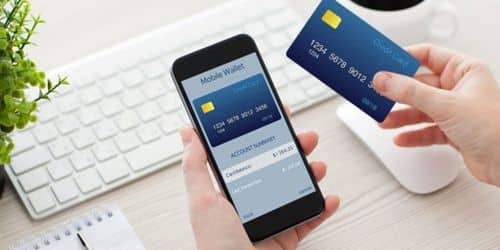The key to success in the e-commerce realm is removing obstacles that stand in the way of the sale. If customers have any trouble making a purchase, then you basically risk losing sales. The lower your bounce rates and the less likely it is that customers will abandon their shopping carts, the more secure and convenient payment options you offer. Ever heard of E-wallet? Yes, using an electronic wallet can greatly simplify the process of making purchases. With near-field communications technology, a consumer can make a purchase with the help of a combination of data and software. This is a form of communication between two smart gadgets that allows them to interact while physically close together. However, how do E-wallet apps work? In this piece, you’ll find out all you need to know about E-wallet with examples.
What is an E-Wallet?
An E-wallet (or electronic wallet) is a type of application for conducting financial transactions using a computer or mobile device.
It is a piece of hardware, an online service, or a piece of software that facilitates the exchange of digital currency units for products and services via the Internet. Mobile payment (through a smartphone or other mobile device) or a laptop (or another personal computer) (for online purchases only) can be used to complete transactions in a variety of settings, including online shopping as well as in-store transactions.
In some circumstances, a person’s bank account can be linked to their E-wallet, while in others, money can be deposited into the wallet beforehand. The wallet may also house the user’s driver’s license, health card, loyalty card(s), and other forms of identification. Using near-field communication (NFC), the credentials can be sent wirelessly to the retailer’s terminal.
Meanwhile, you don’t need to worry about the safety of your info, it keeps your passwords and financial data safe. Hence, you may avoid carrying around a wallet full of cards by downloading an app that allows you to make purchases with your mobile device. This allows you to use your device as a form of payment after entering and storing your payment information (credit card, debit card, or bank account).
How Does an E-Wallet Work?
E-wallets are a sort of pre-paid account that allows users to save money for upcoming online transactions. Generally, it requires a password which helps keep and secure an E-wallet. Using an E-wallet, one can pay for groceries, internet purchases, and tickets to flights, among other things.
E-wallet functions using two key elements; software and data. This piece of software serves as a data repository, protecting and encrypting sensitive information. The information component on the other hand is a database that contains information that the user has submitted, such as their name, shipping address, the preferred method of payment, required payment amount, credit or debit card information, etc.
Installing the E-wallet app and filling out the necessary account information is the first step in getting started with electronic payment systems. When making an online purchase, the E-wallet will prompt the shopper’s personal details for the payment form. The user must however input their password in order to activate their E-wallet. When a customer makes an online payment, their details are saved in a database and are automatically updated, so they don’t have to fill out another order form on another site.
Types of E-wallets
Generally, there are two categories of electronic wallets namely:
- Hot wallets and
- Cold wallets.
They operate on the same principles, except hot wallets have an internet connection whereas cold wallets do not. Hot wallets are most frequently used to send money quickly and easily. On the other hand, a cold wallet is typically used to store digital assets or cryptocurrencies. A hot wallet is a software platform, as opposed to a cold wallet which is physical hardware. The majority of E-Wallet users utilize both hot and cold versions. While hot E-Wallets store user information on safe servers, some people prefer the extra protection that a physical cold wallet offers.
The following are some of the most well-known examples of hot E-Wallet providers:
- ApplePay
- PayPal
- Google Pay (an amalgam of Android Pay and Google E-Wallet)
- Vodafone-M-Pesa
- Galaxy Pay
Examples of the companies that offer cold e-wallet services;
- Ledger
- CoolWallet
- Trezor
- Keepkey
How Does Using an E-wallet Benefit Your Customers?
Customers gain from using an E-Wallet because it paves the way for a seamless transaction that satisfies their needs for speed, ease, and safety. It saves them the trouble of pulling out their debit card every time they want to make an online purchase. And it also eliminates the need to carry around a wallet when they go out. Credit card “long numbers” and other complex passwords are unnecessary. Customers that have their cell phones handy can quickly, easily, and safely purchase whatever it is they’re looking for.
How Does Using an E-wallet Benefit Your Business?
You and your customers can both profit from using an electronic wallet. They can improve the shopping experience and lower cart abandonment rates by removing obstacles at checkout. Hopefully, this will leave a positive impression on your company. The same logic holds true for both online and in-store interactions. Customers will have a better time and wait times will decrease if payment is quick and simple.
Businesses that collect customer data can also benefit from e-wallets because they can gain insight into their clients’ purchasing habits and tailor their marketing strategies accordingly.
How Do I Get an E-wallet?
Getting and setting up an E-wallet is as simple as it gets. You can get an electronic wallet up and running with the below steps;
- Download the e-wallet app.
- Enter relevant information.
- Set a PIN.
- Link your payment cards.
- Make payments.
Does E-wallet Need a Bank Account?
A digital wallet, also known as an e-wallet, is a special kind of electronic card that can be accessed and used to complete financial transactions online using a personal computer or a mobile device. Its usefulness is comparable to that of a debit or credit card. However, to be able to make payments, users will need to link their bank account to their E-wallet.
Can E-wallet Transfer Money to Bank?
It is a simple matter to transfer funds from your E-wallet app on your smartphone to the bank account associated with that account. The fees charged can vary widely from app to app and from transfer method to transfer method. The instant method is always the best though, but it incurs a fee. However, the transaction will be completed in a short amount of time.
Which Bank Does E-wallet?
According to reports, financial institutions; Bank of America, JP Morgan, and Wells Fargo are developing a digital payment wallet. Zelle is a digital payments network that these banks currently own, and they plan to increase its reach. Both PayPal and Apple have been increasing the amount of collaboration between them, which led to both companies gaining a larger market share.
Can Ewallet Be Scammed?
Gaining control of legitimate E-wallet accounts? Yes. scamming is possible. Taking over an account occurs when criminals acquire unauthorized access to accounts, often with the intention of stealing money or stealing personal information. In most cases, the credentials required to access these accounts are stolen and then obtained through social engineering, phishing scams, or information purchased on the dark web.
E-Wallet Examples
To put it simply, an electronic wallet (or “e-wallet”) is a mobile application that may be used to receive, hold, and spend digital currency. E-wallets are a broad category that includes a wide range of apps with varying features. Apple Pay, for instance, can be used at many brick-and-mortar establishments, while Venmo and Cash App are convenient ways to transfer money to friends and family in a flash. Still, it belongs to the category of E-wallets because of its ability to store and transfer funds. Even though the technology has been there for a while, most of the United States continues to rely on plastic cards as their primary form of payment. As a result, the country lags behind the rest of the globe in terms of the use of electronic wallets.
Below are some of the most popular electronic wallet examples in the United States;
#1. Cash App:
It is a digital wallet that enables users to buy bitcoin, send money to pals, and store cards. Users can make use of Cash App for both online and offline(in-store) purchases.
#2. Venmo
Venmo is basically a smartphone application that allows users to link their bank accounts and send money to other Venmo users to pay for goods and services.
#3. PayPal.
PayPal offers is a mobile or web-based electronic wallet that enables users to pay for online transactions and send money to friends and family.
#4. Apple Pay
It is a digital wallet that customers may use to store cards, coupons, tickets, and more that is only available on Apple’s mobile devices. Like a physical card, Apple Pay can be used in many physical stores.
#5. Google Pay
Like Apple Pay, Google Pay also allows users to store card information and make transactions. Those that have a Google account can utilize Google Pay.
What Are 3 Types of Mobile Wallets?
The three main types of mobile wallets. They are
- Opened wallet
- Closed wallets
- Semi-closed wallets
How Do I Send Money Through an E-wallet?
- Tap on the Mobile Number option.
- Simply enter the recipient’s cell phone number to begin the process of sending money to them.
- If you have contacts saved on your device, you may also select the mobile number from one of your contacts by selecting the address book icon that is located next to the mobile number box.
- Simply enter the amount you wish to send in the box provided and off it goes
How Can I Withdraw Money From E-wallet?
You can use a credit card or a debit card to make a purchase at a store that supports this feature. However, you won’t be able to get money out of your E-Wallet without first making a purchase with your card. At the checkout, you can then select the “Withdraw cash” option. It’s possible that you’ll need to inquire with the store’s staff about having this data entered on your behalf.
E-Wallet Apps
Consumers today often prefer using E-wallet apps rather than carrying around a traditional credit card due to the increased security and convenience they offer. A normal digital wallet help stores your credit card information on your smartphone, tablet, laptop, wristwatch, and other mobile devices.
Additionally, many of the newest E-wallet apps contain cutting-edge extra features that make mobile banking and online purchases easier and safer than ever before.
The Top Best E-wallet Apps
Check out the below examples of E-wallet apps if you’re looking for ways to simplify your lifestyle. You will benefit from remarkable ease, whether you’re using it for work or pleasure. hence, if you’re ready to rid of your old wallet and replace it with an electronic wallet, choose your choice now;
- PayPal
- Square Cash App
- Google Wallet
- Venmo
- Samsung Pay
- Google Pay
- FreshBooks Payments
Which E- Apps are the Most Widely Accepted?
In the United States, the most widely accepted E-wallet apps are Google Wallet and Apple Pay. You may access your money and information in both Google Wallet and Apple Pay from any computer with an internet connection and your main Google or Apple account login and password.
If you need to send money quickly on the other hand, whether it’s between friends or from customers to local merchants, Venmo is your best bet.
Is PayPal an eWallet?
PayPal is an E-wallet. This means you’ll be issued a fictitious account that you’ll need to keep active and fund in order to make purchases.
Do I Need an E-Wallet?
Having an electronic wallet is basically not a necessity. But, they do provide a handy alternative to using credit or debit cards when making purchases. It also helps keep your cards more secure. Without having your cards with you all the time, you’re absolutely less likely to lose them.
What Is an E-Wallet Apps Example?
A couple of the most well-known E-wallet apps are Google Pay and Apple Pay. Both services enable you to manage your finances and make purchases from the convenience of your mobile device.
Conclusion
The introduction of E-wallet apps revolutionized the way we make purchases. Taking advantage of digital payment methods is a great way for business owners to save time and effort.
E-wallets facilitate the execution of various monetary transactions, including but not limited to: making purchases online or in-store, paying bills, making deposits, and transferring funds to other entities.
However, the best part is that using an electronic wallet reduces the risk of fraud and ensures that your transactions are executed safely. Using E-wallet apps makes the checkout process quick and easy, leading to increased sales and fewer abandoned carts.
Related Articles
- Trust Wallet: Overview, Tokens, How to Use Trust Wallet
- MOBILE WALLET: Best Mobile Wallets & How to Use It
- What is a Crypto Wallet? Types & How to Use them
- TOP DIGITAL WALLETS IN 2023: How They Work
- Mesmerizing Features For The Bitcoin Android Users



